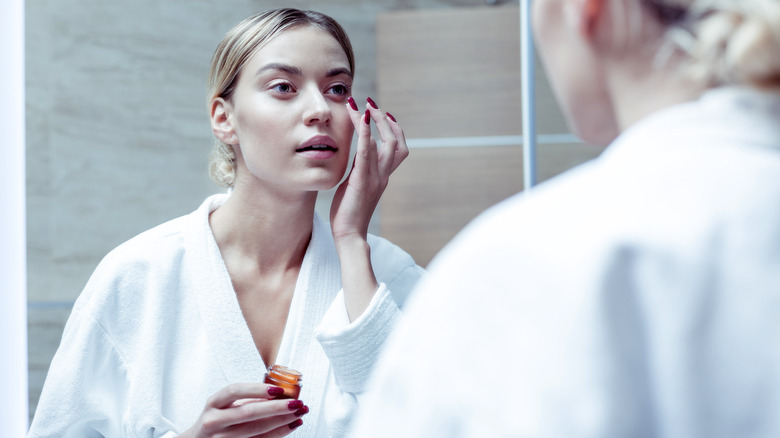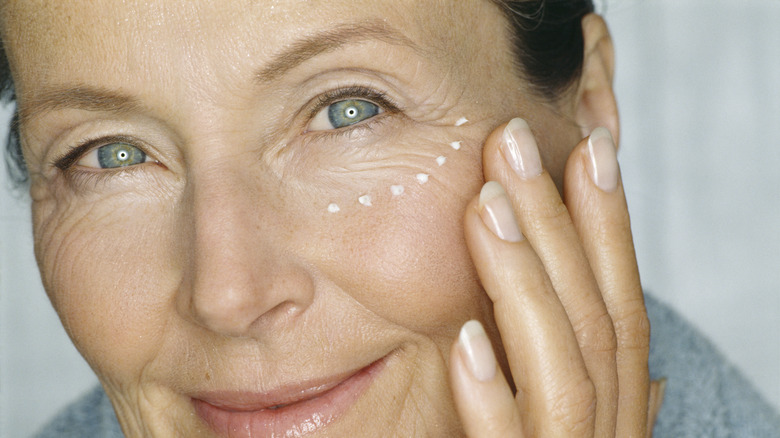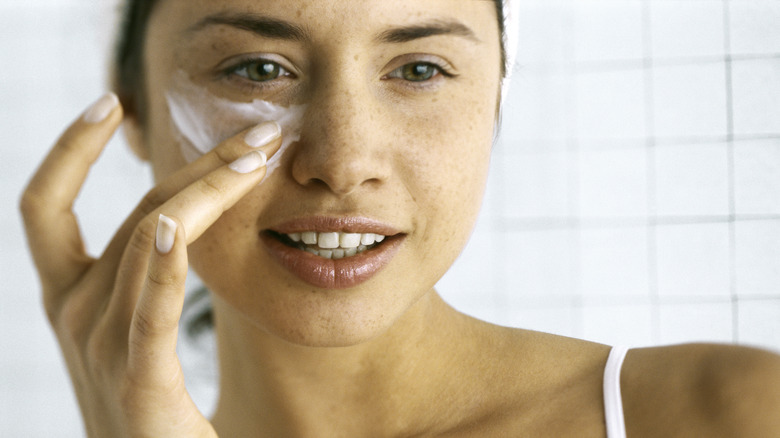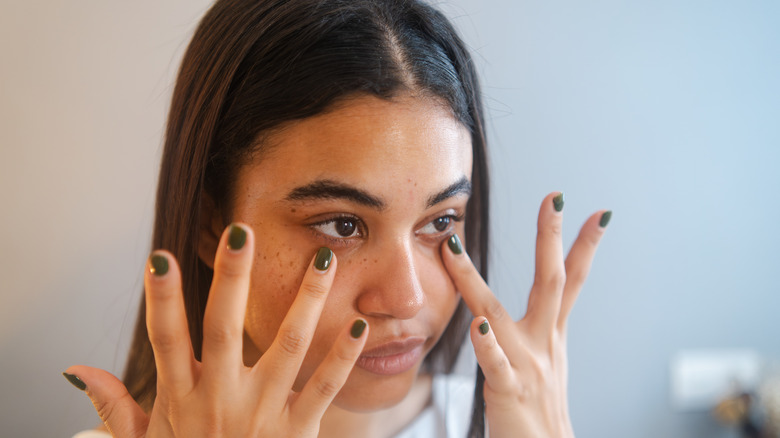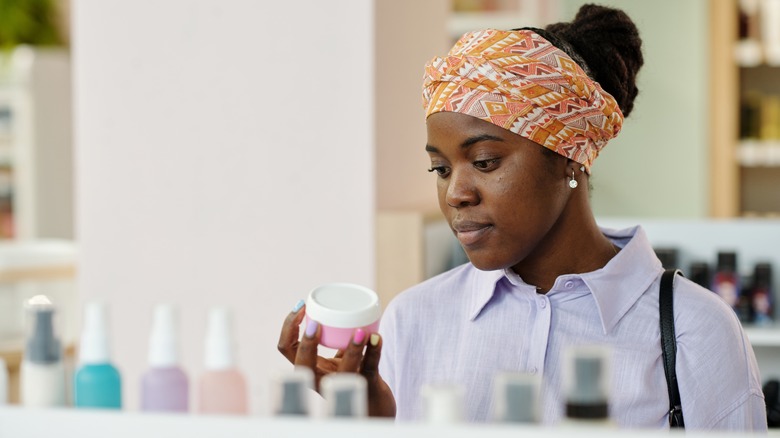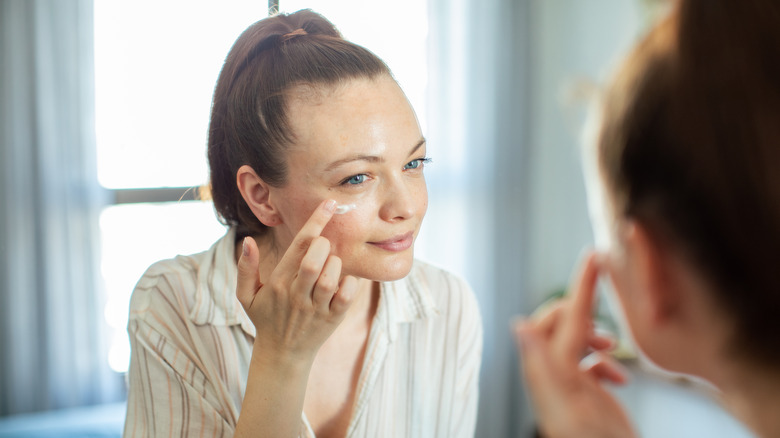The Biggest Mistakes You're Making When Applying Eye Cream
Most skincare gurus will tell you that eye cream is a staple of their routines. Known for brightening dark circles and smoothing over fine lines, this essential product is super important in anti-aging skincare regimens, and some experts even believe you should start using eye cream in your early 20s to prevent skin concerns from becoming unmanageable in the first place. However, regardless of how early you begin using eye cream, it won't have the desired effects if you make the common mistakes that novice users tend to make with this product.
To find out what not to do when using eye cream, Glam spoke exclusively with Beverly Hills-based facial plastic surgeon Dr. Patrick Davis of Davis Facial Plastics. He revealed the five main errors that people tend to make with eye cream, but the good news is they're easy to avoid once you know what you're doing. Using the wrong product for your concern or skin type is perhaps the most significant and common problem, but that's only the beginning. Here's how to get the most out of your eye cream so you protect your skin and don't waste your money.
Mistake: Using the wrong product
The biggest mistake to avoid when it comes to nailing your eye cream application is using the wrong kind of eye cream. "The first priority must be selecting the product that is right for you and that means selecting an oil-free cream if you have oily skin, hydrating cream if you have dry skin, and even-keeled product for those in-between," Dr. Patrick Davis tells us exclusively. Thankfully, there are a few tricks and tips you can follow to determine your skin type, as knowing this will be crucial if you want to buy the right type of eye cream for you. One of the best ways to do this is the blotting method, which simply involves pressing against different areas of your face with a sheet of blotting paper. Next, use good light to see if there are any smears of oil on the paper. Dry skin will result in few to no oil stains, while oily skin will lead to more stains. If you have combination skin, you may only find oil stains coming from some areas of your face, such as your T-zone.
Once you've established the best type of eye cream for your skin type, you'll also need to ensure you're using a cream that has beneficial ingredients regardless of your skin type. "Also, check the label to make sure that it features antioxidants and hyaluronic acid that will hydrate and nourish your skin while offering protection from free radical damage," Dr. Davis adds.
Mistake: Over-applying your eye cream
Eye cream may be an effective product to include in your skincare routine, but that doesn't mean that you need copious amounts of it. "More is NOT better," Dr. Patrick Davis tells us. "Once you've made your selection, read the directions ... sounds silly, but too many consumers have this 'more is better' mindset and tend to misuse beauty products by over-applying." In our exclusive conversation, Dr. Davis warns that using too much product can actually lead to irritation and not provide any additional benefits.
The general consensus is that a pea-sized amount is usually substantial to cover both eyes. However, different formulas of eye cream can require different dosages, which is why it's important to read the instructions, even on a product you think you know well. Take the cream on your ring finger, which usually applies the lightest pressure, and gently pat it into your skin. You can let it set for a few minutes before going in with other products, since experts recommend applying eye cream in the middle of your skincare routine, after cleanser and toner but before your moisturizer.
Mistake: Getting too close for comfort
One of the reasons why using less eye cream is advisable is because large amounts can often end up flooding too close to the eyes. Dr. Patrick Davis explains exclusively to Glam that eye cream is intended for the skin around the eyes rather than the eyes themselves, and getting too close can lead to problems. "When applying the cream, make sure to avoid the eyelids and the lash line, as it's likely to seep into your eyes, causing superficial burns and irritation," he says. "Instead, gently apply the product starting on the inner corner of your eye and work your way outward."
Though some eye creams may be safe to use on the eyelids, this will be indicated in the instructions. Even with products that are safe for this area, it should still be avoided if you have a skin condition that may flare up as a result. If you're ever unsure about using eye cream on your eyelids, speak to your dermatologist after reading the packaging of your product.
Mistake: Paying too much for your eye cream
While Dr. Patrick Davis stresses the importance of finding the right eye cream for you rather than just settling for any old product, that doesn't mean you have to invest in super-expensive or luxe brands. These might feel nice, but a high price point isn't always indicative of the best product, and you might be able to get the same results while paying less. "Price does not necessarily equate with quality so no need to spend a fortune on a product when you have affordable selections at the ready," he tells Glam exclusively. "Your local drugstore most likely will carry a product that will do the job."
Comparing the ingredient lists of your favorite costly products with drugstore alternatives can be helpful. Often, you'll find that the key ingredients are the same, and you're actually paying for the brand itself rather than for a superior product. You could also try looking for online reviews of highly rated eye creams to give you an idea of those that get results without costing a fortune.
Mistake: Applying your eye cream at the wrong time
We've already established that eye cream should come in the middle of your routine, but Dr. Patrick Davis specifies that this product is best used before bed. "Timing is everything," he shares exclusively with Glam. "For maximum benefit, it's best to use the product at bedtime so that it thoroughly penetrates the skin as you sleep." Some people find it useful to use a lighter-weight eye gel in the morning to target issues like dark circles, but for heavier creams, their absorption may be interrupted by any makeup you put on throughout the day.
Some eye creams indicate that they should be used both in the morning and at night, but just be aware that you'll likely need a significant period of time for the product to sink in, and your daytime activities may affect the efficacy of this. A pillowcase protector might be in order to ensure your overnight skincare doesn't end up on your bedding, but this is the best way to get value out of your eye cream and allow it to do its job.
